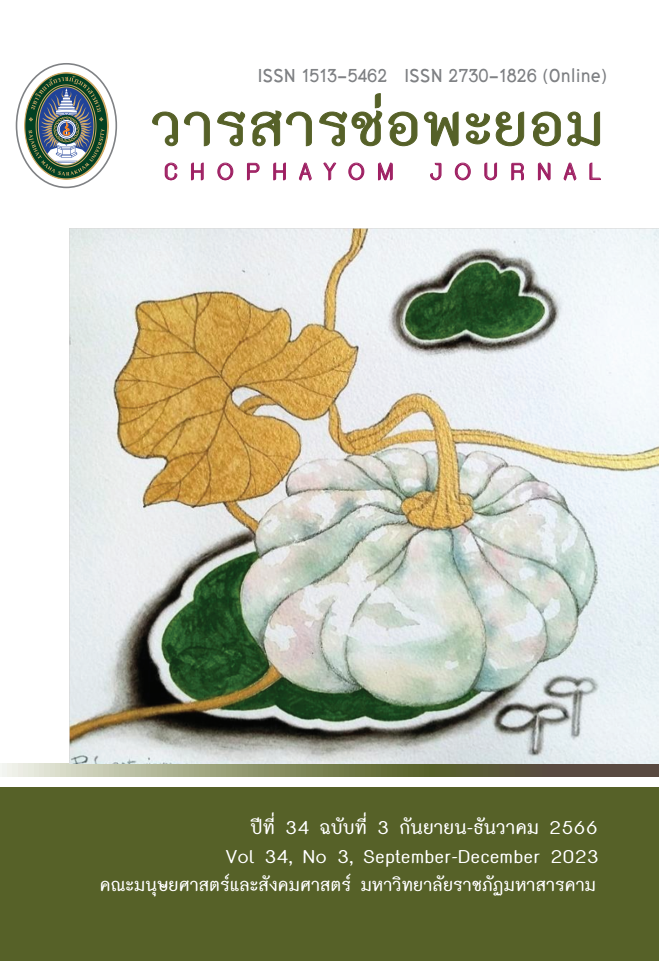The Use of Language in Keynote Address on Thai Language and Literature by Prime Minister of Thailand: Case Study of M.R. Kukrit Pramoj and Mr. Chuan Leekpai
Keywords:
Uniqueness, Identity, Language, Keynote Address, Thai Prime MinisterAbstract
This study aims to analyze the use of language in Keynote Address on Thai language and literature of M.R. Kukrit Pramoj and Mr. Chuan Leekpai and to synthesize the uniqueness and identity of language use in Keynote Address on Thai language and literature by M.R. Kukrit Pramoj. and Mr. Chuan Leekpai by selecting a speech on Thai language and literature of the two people, 1 chapter each, and then analyzing it mainly from the text. According to the theory of words and phrases that the researcher has synthesized. The results of a study of M.R.Kukrit Pramoj's keynote address on Thai language and literature found that the use of nouns, pronouns,
conjunction, suffixes, and transliteration. Chuan Leekpai's discourse on Thai language and literature found the use of nouns, pronouns, conjunctions, simile, and local languages. Synthesis of the uniqueness and identity of language use in Keynote Address on Thai language and literature by M.R. Kukrit Pramoj. and Mr.Chuan Leekpai found that appeared to use words and phrases that show the common characteristics of the two people. In the use of language found the use of words and phrases in 3 characteristics that are the same consisting of the use of nouns, pronouns, and the use of conjunctions. It was found that the use of Common Noun, Proper Noun, Personal Pronoun, and the use of many conjunctions regarded to the identity of the use of language, it was found that M.R.Kukrit Pramoj used words and phrases that were characterized
by the use of conjunctions including the use of many polite endings and the use of English transliteration to accompany the speech. Mr.Chuan Leekpai's speech is different from M.R.Kukrit's speech because M.R. Kukrit used content from literature obviously. Chuan Leekpai's speech was about local dialects. Therefore, the content of Mr.Chuan Leekpai provided examples of local dialects, especially the Southern dialects to describe and references to well-known people in society. There was the use of idioms and metaphor, with and without word of comparison for gaining the weight of speech to persuade the audience to see the importance of the dialect better.
Keywords: Uniqueness, Identity, Language, Keynote Address, Thai Prime Minister
References
คึกฤทธิ์ ปราโมช, หม่อมราชวงศ์. (2553). “สามก๊ก”ในทรรศนะของข้าพเจ้า. ใน นิตยา มาศะวิสุทธิ์ (บรรณาธิการ), คึกฤทธิ์พูด: วรรณกรรมกับสังคม. (น. 8-12). ขอนแก่น: ขอนแก่นการพิมพ์.
ชวน หลีกภัย. (2538). ภาษาถิ่นก็ภาษาไทย. ใน นิตยา มาศะวิสุทธิ์ และคณะ (บรรณาธิการ), วารสารภาษาและหนังสือฉบับพิเศษ : ภาษาไทยของเรา. (น. 23-31). ปีที่ 26 ฉบับที่ 1-2 (เม.ย. 2537 – มี.ค. 2538). กรุงเทพฯ: โรงพิมพ์คุรุสภาลาดพร้าว.
จุไรรัตน์ ลักษณะศิริ และวีรวัฒน์ อินทรพร. (2558). ภาษาไทยเพื่อการสื่อสาร. (พิมพ์ครั้งที่ 2). นครปฐม: โรงพิมพ์มหาวิทยาลัยศิลปากร.
ธัญญา สังขพันธานนท์. (2539). วรรณกรรมวิจารณ์. กรุงเทพมหานคร: นาคร.
ปรมาพร สว่างแก้ว. (2556). ลีลาภาษาของ คำ ผกา ในบทความทางการเมืองที่ตีพิมพ์ลงในมติชนสุดสัปดาห์ พ.ศ. 2553-2554. (วิทยานิพนธ์ศิลปศาสตรมหาบัณฑิต, มหาวิทยาลัยขอนแก่น).
พลอย ลวณะมาลย์. (2547). การศึกษาเชิงวิเคราะห์ลีลาภาษาในงานวรรณกรรมประเภทสารคดีประวัติศาสตร์ของ ม.ร.ว. คึกฤทธิ์ ปราโมช. (วิทยานิพนธ์ศิลปศาสตรมหาบัณฑิต, มหาวิทยาลัยเกษตรศาสตร์).
รื่นฤทัย สัจจพันธุ์. (2561). หน่วยที่ 15 การสังเคราะห์ความรู้จากการอ่าน. ในมนัสนันท์ จริตงาม (บรรณาธิการผู้ช่วย), เอกสารการสอนชุดวิชา การอ่านภาษาไทย หน่วยที่ 9-15. (น. 15-36 – 15-39). นนทบุรี: สำนักพิมพ์มหาวิทยาลัยสุโขทัยธรรมาธิราช.
รุ่งโรจน์ ต้นประดิษฐ, วิเชษฐชาย กมลสัจจะ และวรวรรธน์ ศรียาภัย. (2564). การเชื่อมโยงความในบทปาฐกถาทางภาษาและวรรณกรรมไทยของนายกรัฐมนตรีไทย. วารสารช่อพะยอม, 32(1), 131-153.
วรวรรธน์ ศรียาภัย. (2557). การเขียนเพื่อการสื่อสาร. (พิมพ์ครั้งที่ 2). กรุงเทพฯ: สำนักพิมพ์แห่งจุฬาลงกรณ์มหาวิทยาลัย.
วรวรรธน์ ศรียาภัย. (2560). พูดให้สัมฤทธิผล : หลักการและศิลปะวิธี. กรุงเทพฯ: โรงพิมพ์แห่งจุฬาลงกรณ์มหาวิทยาลัย.
วิจินต์ ภาณุพงศ์ และอนันต์ เหล่าเลิศวรกุล. (2552). บทที่ 2 ชนิดของคำ. ในวิจินตน์ ภาณุพงศ์ และคณะ (บรรณาธิการ), บรรทัดฐานภาษาไทย เล่ม3: ชนิดของคำ วลี ประโยคและสัมพันธสาร. (น. 16-65). กรุงเทพฯ: สถาบันภาษาไทย สำนักวิชาการและมาตรฐานการศึกษา สำนักงานคณะกรรมการการศึกษาขั้นพื้นฐาน กระทรวงศึกษาธิการ.
สุนันท์ อัญชลีนุกุล. (2563). หน่วยที่ 3 คำและการสร้างคำในภาษาไทย. ในพรพิมล นุ่นปาน (บรรณาธิการผู้ช่วย), เอกสารการสอนชุดวิชา ลักษณะภาษาไทย หน่วยที่ 1-7. (น. 3-5 – 3-34). นนทบุรี: สำนักพิมพ์มหาวิทยาลัยสุโขทัยธรรมาธิราช.
Downloads
Published
How to Cite
Issue
Section
License
Copyright (c) 2023 Chophayom Journal

This work is licensed under a Creative Commons Attribution-NonCommercial-NoDerivatives 4.0 International License.






